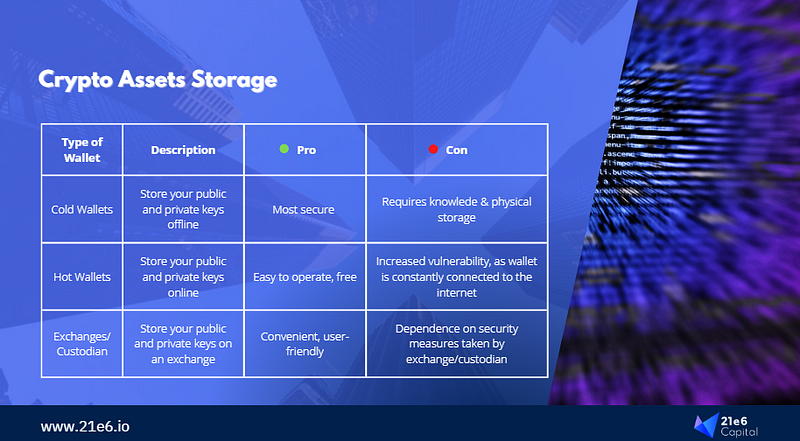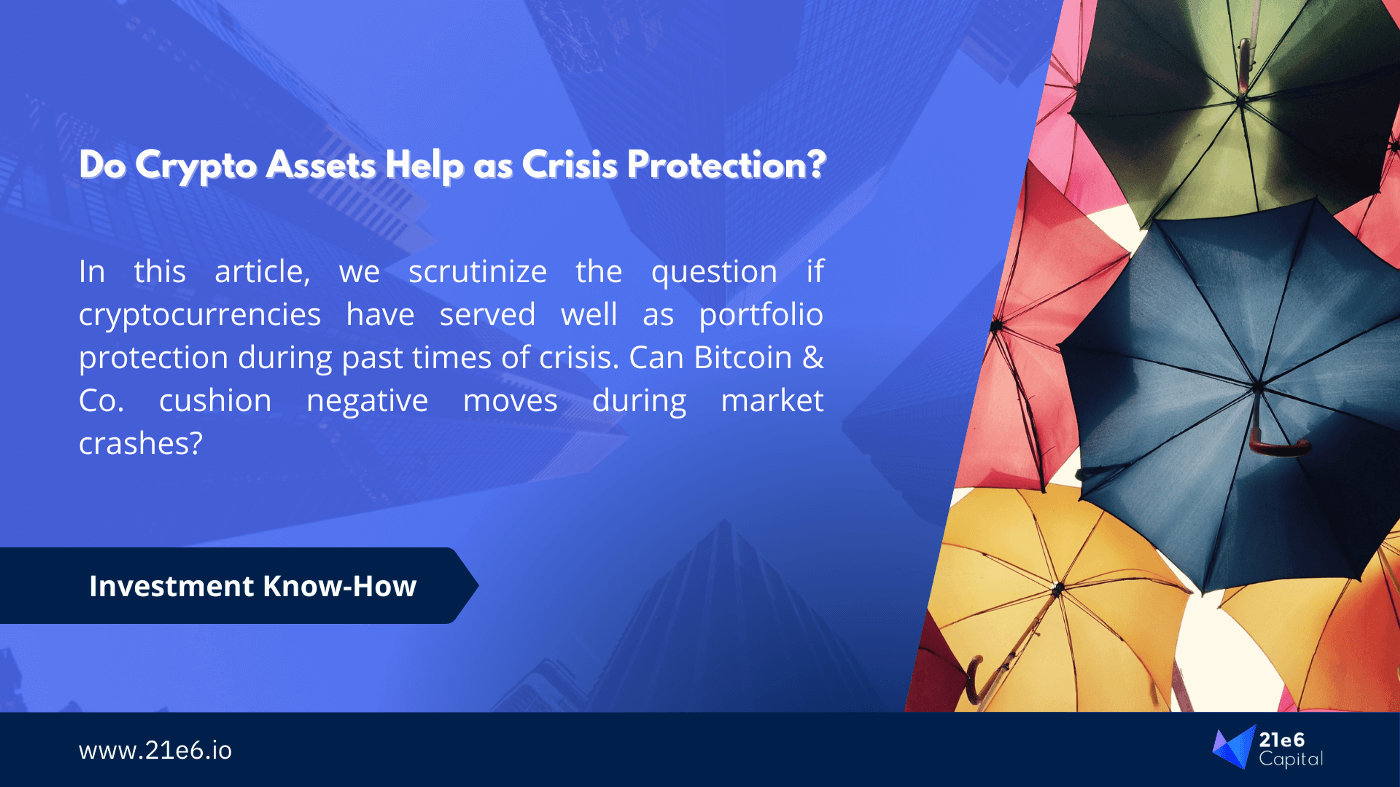An Intro To Investing In Crypto Assets For Professional Investors
An Intro To Investing In Crypto Assets For Professional Investors
The crypto universe is growing, with more professional investors from around the world getting on board every year and following Michael Saylor’s lead (albeit on a smaller scale). Not only are crypto assets themselves exciting, the entire blockchain ecosystem is growing rapidly and VC investments are growing with it, as can be seen by the many blockchain unicorns. Even traditionally more conservative investors are considering adding crypto to their portfolios, but often fail to take the first step. The hurdles are too big, they say, and they don’t even know where to start. This article aims to somewhat facilitate exactly this difficult first step, with the goal of explaining through which channels professional investors can invest in crypto assets.
Authors: Maximilian Bruckner, Felix Fernandez
Centralized exchanges, hot wallets and cold wallets
The most obvious path to crypto investing would probably be to set up your own account with one of the popular centralized crypto exchanges and buy crypto assets directly through them. This way, you'd have full control over which assets you want to buy, and you can sell anytime within a few minutes, thanks to the high liquidity. These exchanges essentially set up a wallet for you, which is basically your address on the blockchain. Alternatively, you could use a separate wallet provider like metamask and send your assets to this address. This way, you do not use the centralized exchange as your custodian anymore. However, these "hot wallets" are permanently connected to the internet. While using your own wallets and buying through large exchanges gives you the most control and access to the largest variety of crypto assets, the risks are also high. Holding large amounts of crypto in your own hot wallet could be compared to carrying around all of your portfolio's securities, stocks, and other investments permanently in a wallet, or keeping 100 kg of gold in your own vault in your house. You would feel uncomfortable with the level of security this would grant in the real world, so why would you store your crypto assets that way? There is a risk of being robbed. In the crypto world, there is little reliable insurance here - gone is gone.

"Cold wallets" can be considered as a safer option; these are not connected to the internet. As a result, cold wallets cannot be hacked, but setting them up is more complex and selling assets held on cold wallets takes longer and is also more complicated. A more simple alternative would be to trade through exchanges that offer fiduciary custody, as has always been the case in the traditional financial sector. The Börse Stuttgart Digital Exchange (BSDEX), for example, offers these options, coupled with an easy-to-use interface and the trusted background of a financial services provider regulated in Germany. Diversification might prove difficult here, however; the selection of tradable crypto assets is more limited in this particular example (at least currently).
Generally, the more control you want to have, the more complex the process becomes, and the more knowledge you need to acquire. One requires the technical knowledge to operate a wallet, one should be informed about the current regulatory and tax aspects, and one needs to manage their portfolio completely by himself. In order to effectively manage risks and achieve good returns, one would need to have the skills of an asset manager specialized in crypto assets. Therefore, in our opinion, this approach is not the right one for all professional investors who want to "give crypto assets a try".
Crypto ETPs, ETNs, and Certificates
Regulated financial products for crypto assets in the form of ETPs, ETNs, and certificates are also a valid option. Sometimes, it's even possible to purchase these directly via your local bank. In most cases, these instruments are essentially passive wrappers, i.e. they form a "shell" around individual crypto assets, which are held by the issuer of the instrument. The advantages: easy and fast buying and selling, as well as transparent tax treatment. No technical know-how required, as one bypasses the wallet issue completely here. However, by buying crypto ETPs, investors expose themselves to an issuer risk that would not exist when buying directly. The costs are also higher: you can expect to see a total expense ratio of about 250 basis points plus spread. Also, most of the other issues associated with buying crypto with your own wallets remain. Risk management and rebalancing has to be done by oneself, and the choice of crypto assets is very limited.
For investors who still feel comfortable in this category for the sake of simplicity, crypto index ETNs offer a slightly better option. As a hybrid solution, such ETNs achieve better diversification than ETPs or certificates of individual crypto assets, but these ETNs are almost always cap-weighted. This means over 60% is invested in Bitcoin and Ethereum. In addition, an index is only of limited use for crypto assets, as the correlation within the universe (i.e. between Bitcoin and other crypto assets) is still relatively high. Further, this approach is still a simple "long-only" strategy with full market beta. A 1–5% addition of crypto ETNs in the portfolio is still a good option for people who do not want to look further into the topic.
Crypto funds and fund-of-funds
The crypto fund universe is growing. At the time of writing, there are more than 1,100 crypto funds active worldwide. These pursue various active strategies, from long/short to arbitrage and market-making -hence offering significantly more options than ETPs and ETNs. For a complete overview of the crypto fund ecosystem, take a look at our crypto fund database with over 1,100 crypto funds, click here for more details. For investors looking for blockchain exposure but which are not yet ready to invest in cryptocurrencies themselves, there are also numerous venture capital funds. These act like regular tech-specialized venture capital funds, but with a focus on blockchain startups. Figure 2 shows the different strategies of crypto funds. We recently published an article focused specifically on the crypto fund ecosystem, where we analyzed their domicile, assets under management, new fund launches, and more. You can read into our map of the growing crypto fund universe here.

Crypto funds of funds (FoF) can be seen as the "carefree package" of crypto investing. Investors have the opportunity to invest in a regulated vehicle directly through their house bank, via standard subscription process, and do not have to worry about technological, tax or other issues. Of course, one pays a certain premium for this, but funds of funds offer another, significant dimension compared to all other vehicles: Diversification across different investment strategies, styles, and fund managers. Through appropriate portfolio construction via strategic asset allocation, a FoF can achieve uniquely risk-adjusted returns. It is possible to reduce drawdowns to the level of global equities while retaining most of the high returns characteristic of crypto assets. This style diversification therefore opens up a much broader solution space when constructing a portfolio, as the FOF managers can allocate between market neutral and beta strategies.
Conclusion
While running your own wallet like metamask or ledger is the most cost-saving and offers the most individual control, it also requires the most expertise in technology, asset management, and crypto markets. ETPs and certificates of individual crypto assets greatly simplify investing, but they are comparatively expensive and only exist for the largest cryptocurrencies. Diversification at crypto asset level is possible through a few index ETPs, but one continues to drive a "long-only" strategy here and the high volatility remains. Moreover, the crypto market is highly correlated with bitcoin in any case. Funds and funds of funds offer different, active strategies. Funds of funds could thus achieve returns in the typical crypto range with greatly reduced drawdowns through allocation in market neutral strategies like arbitrage and market making.
Remarks
This article is an informational document and does not constitute an investment recommendation, investment advice, legal, tax or accounting advice or an offer to sell or a solicitation to purchase any securities and therefore may not be relied upon in connection with any offer or sale of securities. The views expressed in this letter are the subjective views of 21e6 Capital personnel, based on information which is believed to be reliable. Any expression of opinion (which may be subject to change without notice) is personal to the author and the author makes no guarantee of any sort regarding accuracy or completeness of any information or analysis supplied.
If you like this article, we would be happy if you forward it to your colleagues or share it on social networks. If you are an expert in the field and want to criticize or endorse the article or some of its parts, please feel free to leave a private note here or contextually, and we will attempt to respond or address the same.
About 21e6
21e6 Capital is a Swiss investment advisor, connecting professional investors with optimal crypto investment products. 21e6 Capital has analyzed over 1,000 crypto funds across the world and condensed them into a selection that can yield crypto-exposure with minimized downside risk. Backed by a highly experienced team of crypto and finance experts with in-depth knowledge in digital assets and DLT, 21e6 Capital created a unique quantamental strategy that is aimed at achieving crypto-like returns while minimizing risk and volatility to global equity levels. The 21e6 Capital team builds upon strong academic roots with a track record of leading crypto asset and decentralized finance publications and research, ensuring state-of-the-art crypto investment solutions for financial industry professionals.
Authors
Maximilian Bruckner is Head of Marketing & Sales at 21e6 Capital AG. Prior to this, he was engaged as Executive Director of the International Token Standardization Association (ITSA) where he focused on research and classification of crypto assets according to the International Token Classification (ITC) framework. He was heavily involved in the creation of the world’s largest token database for classification and identification data on tokens (TOKENBASE). Maximilian did academic research in close consultation with Prof. Dr. Philipp Sandner. You can contact Maximilian via e-mail at maximilian.bruckner@21e6.io to request more information on 21e6 Capital AG or ask any questions regarding this article. You can also follow Maximilian on LinkedIn (https://www.linkedin.com/in/max-bruckner/) to stay up to date.
Felix Fernandez has recently taken on the role of CEO of 21e6 Capital AG. Felix works in parallel as CEO for OpenMetrics Solutions in Zurich. He has more than 20 years of experience in the financial industry and previously held top management positions at Deutsche Börse Group. After a long career in the corporate customer business, he joined the Rmetrics Association in 2016 as a research fellow led by Prof. Diethelm Würtz at ETH Zurich. In the same year, he co-founded OpenMetrics Solutions as an ETHSpinoff. Felix holds a degree in computer science.
You May Also Like
These Related Articles



